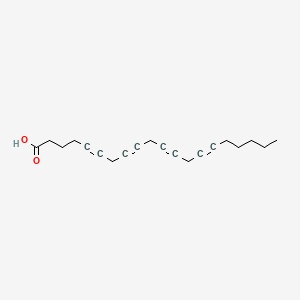| Weiss DJ and Evanson OA |
Evaluation of lipopolysaccharide-induced activation of equine neutrophils. |
2002 |
Am. J. Vet. Res. |
pmid:12061525
|
| Soldati L et al. |
Arachidonic acid increases intracellular calcium in erythrocytes. |
2002 |
Biochem. Biophys. Res. Commun. |
pmid:12051755
|
| Ito Y et al. |
Exercise training increases membrane bound form of tumor necrosis factor-alpha receptors with decreases in the secretion of soluble forms of receptors in rat adipocytes. |
2002 |
Life Sci. |
pmid:12052444
|
| Silldorff EP et al. |
Angiotensin II constriction of rat vasa recta is partially thromboxane dependent. |
2002 |
Hypertension |
pmid:12364360
|
| You J et al. |
Role of cytoplasmic phospholipase A2 in endothelium-derived hyperpolarizing factor dilations of rat middle cerebral arteries. |
2002 |
J. Cereb. Blood Flow Metab. |
pmid:12368663
|
| Shrestha R et al. |
N-acylethanolamines are metabolized by lipoxygenase and amidohydrolase in competing pathways during cottonseed imbibition. |
2002 |
Plant Physiol. |
pmid:12226518
|
| Kintscher U et al. |
PPARalpha inhibits TGF-beta-induced beta5 integrin transcription in vascular smooth muscle cells by interacting with Smad4. |
2002 |
Circ. Res. |
pmid:12456495
|
| Bianchi A et al. |
Induction of MnSOD gene by arachidonic acid is mediated by reactive oxygen species and p38 MAPK signaling pathway in human HepG2 hepatoma cells. |
2002 |
Free Radic. Biol. Med. |
pmid:12031898
|
| Chen N et al. |
Inhibition by arachidonic acid and other fatty acids of dopamine uptake at the human dopamine transporter. |
2003 |
Eur. J. Pharmacol. |
pmid:14575792
|
| Carr MJ et al. |
A role for TRPV1 in bradykinin-induced excitation of vagal airway afferent nerve terminals. |
2003 |
J. Pharmacol. Exp. Ther. |
pmid:12604706
|
| Jelson GS et al. |
Modulation of guinea pig intrinsic cardiac neurons by prostaglandins. |
2003 |
Am. J. Physiol. Regul. Integr. Comp. Physiol. |
pmid:12791585
|
| Bell MV et al. |
Pyloric ceca are significant sites of newly synthesized 22:6n-3 in rainbow trout (Oncorhynchus mykiss). |
2003 |
Lipids |
pmid:12669818
|
| Sergeeva M et al. |
Arachidonic acid in astrocytes blocks Ca(2+) oscillations by inhibiting store-operated Ca(2+) entry, and causes delayed Ca(2+) influx. |
2003 |
Cell Calcium |
pmid:12618149
|
| Moneer Z et al. |
Nitric oxide co-ordinates the activities of the capacitative and non-capacitative Ca2+-entry pathways regulated by vasopressin. |
2003 |
Biochem. J. |
pmid:12459038
|
| Oltman CL et al. |
Reactive oxygen species mediate arachidonic acid-induced dilation in porcine coronary microvessels. |
2003 |
Am. J. Physiol. Heart Circ. Physiol. |
pmid:12869369
|
| Carattino MD et al. |
Arachidonic acid regulates surface expression of epithelial sodium channels. |
2003 |
J. Biol. Chem. |
pmid:12837767
|
| Bryja V et al. |
Lipoxygenase inhibitors enhance tumor suppressive effects of jun proteins on v-myb-transformed monoblasts BM2. |
2003 |
Prostaglandins Other Lipid Mediat. |
pmid:14674625
|
| Sokolowski BH et al. |
Identification and localization of an arachidonic acid-sensitive potassium channel in the cochlea. |
2004 |
J. Neurosci. |
pmid:15254081
|
| Zuo L et al. |
Lipoxygenase-dependent superoxide release in skeletal muscle. |
2004 |
J. Appl. Physiol. |
pmid:15107407
|
| Bandell M et al. |
Noxious cold ion channel TRPA1 is activated by pungent compounds and bradykinin. |
2004 |
Neuron |
pmid:15046718
|
